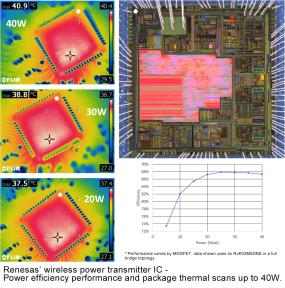Renesas Electronics Corporation, a provider of advanced semiconductor solutions, showcased advances in charging technology for mobile devices at the prestigious International Solid State Circuits Conference (ISSCC) in San Francisco last week.

Renesas IC Wireless Power Transmitter
During the conference, Renesas described its single-chip wireless power transmitter solution that measures AC and DC transmitter power for greater accuracy and security. The presentation included details of a zero-voltage adaptive switching (ZVS) transmitter technology that achieves reduced electromagnetic interference (EMI) and increased power transmission efficiency.
These technical features enable wireless power transmission of up to 15W with a Qi Power Receiver (PRx) and up to 40W with proprietary PRx solutions.
Coil current sensor
Renesas is the first in the industry to develop single-chip transmitter (Tx) technology that can directly measure DC and AC power transmission components. With this approach, transmitted power can be measured more accurately, providing a means to accurately detect a mismatch between transmitter power (PTx) and PRx power levels.
Additionally, DC and AC coil current detection can detect whether a small foreign metallic object, such as a paperclip, is stuck between the transmitter and receiver – which could otherwise cause the object to heat up and compromise the security. The transmitter is equipped with analog AC coil current sensors and supports up to four transmitter coils to increase the charging area, improving the end user's charging experience.
Zero Voltage Switching
One of the key innovations described in the ISSCC presentation was adaptive ZVS, which ensures that power MOSFETs switch after the drain source voltage drops to 0V, reducing switching losses and increasing efficiency. Because this adaptive ZVS technology operates over wide load conditions, it is ideal for half-bridge inverters that supply varying loads.
Additionally, this ZVS technology reduces EMI, decreasing the amount of energy that is converted into electromagnetic noise. When compared to conventional methods, the use of ZVS decreases EMI by 4 decibels (dB) and can increase PTx efficiency by 1.7% or more.
ZVS also helps extend the operational life of power systems in many applications, such as in-cab automotive chargers, by automatically calibrating the initial comparator threshold.
Additionally, the system features a highly programmable pulse width modulation (PWM) generator, which controls the transmitter's power delivery characteristics to ensure the device being charged receives the right amount of power. This improves the accuracy and stability of the charging process and provides more control over the energy delivered.
“With the integration of these innovative technologies, new wireless charging systems are expected to change the way portable devices are charged,” said Filippo Neri, senior manager of Electrical Engineering at Renesas’ Mobility and Industrial Energy Infrastructure Division, co-author of the article. . “For example, foreign object detection is a very important safety feature when wirelessly charging devices. We are committed to developing these and other features to provide fast and safe charging experiences for everyone.”
These technical enhancements have been applied to some Renesas wireless power transmitter ICs that are currently available.

